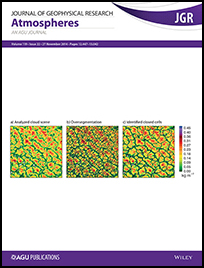Atmospher Sci & Global Chg
Staff Awards & Honors
January 2015
Cloud Research Featured on Cover of JGR Atmospheres
Congratulations to Dr. Matus N. Martini, a postdoctoral researcher in atmospheric sciences at Pacific Northwest National Laboratory, who led research that was featured on the November cover of the Journal of Geophysical Research: Atmospheres.
Martini and his PNNL colleagues Drs. William I. Gustafson Jr., Qing Yang and Heng Xiao developed a new automated method to target marine cloud features. Because these clouds are important for understanding climate, the scientists developed the new method to automatically identify the features in climate models so the clouds can be analyzed in more detail. They then applied their technique to look at a model's ability to simulate these clouds at two different resolutions.
"We named the new technique "dynamically guided watershed segmentation," because it has similarities with the technique used to identify watersheds in topography," said Martini. "Our findings will help researchers understand the need to use finer resolution models to better capture the role of marine clouds in Earth's energy budget."
Low, shallow clouds called marine stratocumulus hover over the oceans. As bright clouds, stratocumuli reflect the sun's energy back into space, which limits the ocean's role as the world's heat-storage tank. These oceanic clouds are also formed around exhaust released by ships, often called "ship tracks." There is some interest in using similar techniques to engineer the climate by artificially generating these clouds over the ocean. While only a theory now, successful climate engineering demands thorough understanding of cloud processes and cloud modeling.
Martini and colleagues used simulations from the Weather Research and Forecasting model with chemistry (WRF-Chem) at a cloud-scale resolution to understand how future climate models would simulate these clouds. Because of intricate interactions between many cloud processes, like evaporation and condensation, and turbulent circulations inside each cloud, these clouds often self-organize into convective cells called "closed cells." These complex interactions pose modeling challenges that the PNNL researchers tackled with high-resolution WRF-Chem simulations. Using their new automated cloud detection technique, they were able to identify the boundaries of the closed cells over the Pacific Ocean during the Variability of the American Monsoon Systems Ocean-Cloud-Atmosphere-Land Study Regional Experiment (VOCALS-REx) field campaign.
In addition to showing great potential as a new way to quickly and effectively identify marine stratiform cloud characteristics, the technique is a promising start for future applications. This research will advance development of cloud modeling for global models, one of the great challenges in climate modeling.
Acknowledgments
Sponsor: Funded by the U.S. National Oceanic and Atmospheric Administration's (NOAA's) Atmospheric Composition and Climate Program
Research Team: Matus N. Martini, William I Gustafson Jr., Qing Yang, and Heng Xiao, PNNL
Research Area: Climate & Earth Systems Science
Reference: Martini MN, WI Gustafson Jr., Q Yang, and H Xiao. 2014. "Impact of Resolution on Simulation of Closed Mesoscale Cellular Convection Identified by Dynamically Guided Watershed Segmentation." Journal of Geophysical Research: Atmospheres 119: 12,674-12,688. DOI:10.1002/2014JD021962

